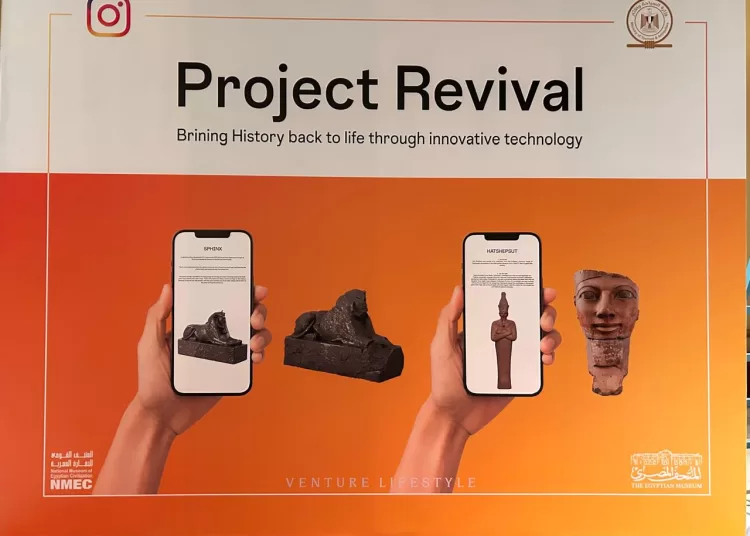Imagine stepping into the grand entrance of the Egyptian Museum in Tahrir Square, a place where history seems to stand still — a serene expanse filled with relics from an ancient world.
This majestic setting, however, is now on the cusp of a technological revolution aimed at transforming how we experience history.
Through an innovative project between Meta and Egypt’s Tourism and Antiquities Ministry that leverages augmented reality (AR), the museum is allowing visitors to connect with Egypt’s past in ways previously unimaginable.
Take, for instance, the exquisite painted limestone head of Queen Hatshepsut. Without the context of its original form, the artefact is a beautiful yet incomplete monologue of history.

But with the wonders of AR, visitors can now see beyond the fragment and envision Hatshepsut as she might once have been — a full-bodied figure that stands as a tribute to the first great female pharaoh of Egypt. Through a simple gesture of raising an Instagram camera in front of her QR code, the artefact transitions from a mere historical fragment to a vibrant narrative. This is not just about seeing; it is about experiencing history with all its lost grandeur restored.
This remarkable technological integration is powered by Meta’s Spark AR technology, which seamlessly blends digital imaging with the tangibility of artefacts to create an immersive experience. It marks an extraordinary intersection where historical intrigue marries modern technological advancement, enabling a visual and interactive restoration of Egypt’s artefacts.
Initiated in 2022, the collaboration between Meta and Egypt’s Ministry of Tourism and Antiquities signifies a leap forward in cultural engagement.

Through the meticulous work of Spark AR’s advanced capabilities, high-resolution scans of artefacts are expertly reconstructed under the meticulous eyes of museum specialists.
The project’s unveiling coincided with the Egyptian Museum in Tahrir’s 122nd anniversary, a milestone highlighting the institution’s unyielding dedication to integrating cultural heritage with contemporary innovation.
This digital enhancement journey did not end there. A day after its launch on November 12, the project extended its technological embrace to the National Museum of Egyptian Civilisation in Fustat.
Tourism and Antiquities Minister Sherif Fathy said that this project represents a forward leap in integrating technology with the presentation of Egypt’s storied past, enhancing visitor interaction with Egyptian heritage through social media platforms.
“Our mission has always been to make Egypt’s remarkable cultural treasures reachable and captivating for audiences worldwide,” Fathy said.
“By incorporating AR technology, we’re connecting these stories with tech-savvy younger generations while safeguarding the authenticity of these invaluable artefacts,” he added.
Arguably the most iconic of all the digital reconstructions are the selected pieces from the impressive collection housed at the Egyptian Museum.
Dr Ali Abdel Halim, general director of the Egyptian Museum, said his team selected five royal artefacts, with Hatshepsut, the renowned queen, being the most significant figure.
“Queen Hatshepsut’s legacy shines brightly, serving as a powerful reminder of her profound impact on Egypt, particularly advocating women’s progressive roles during her reign,” he told The Egyptian Gazette.
Abdel Halim highlighted the essence of the project, stating, “Our ambition was to restore dimensions of our heritage that had previously been lost to time – providing a richer, more comprehensive understanding of these monumental figures from our history.”

Consider the regal portrayal of King Khasekhem from the 2nd Dynasty (2649-2676 BC), crowned with the White Crown of Upper Egypt, or the massive grey granite statue of King Senusret, with Ramesses II and his son, Prince Meneptah, depicted at its rear.
These augmented reality applications go beyond mere physical boundaries — they capture the essence of uniting different eras and locations, enabling users to journey through centuries with a simple swipe on a screen.
Even more profound is the restoration of pieces like the statue of Amun, a critical figure from Egyptian mythology.
Amun’s fragmented sculpture represents a saga of artistic brilliance and historical dispersal — from its initial discovery in Karnak to pieces distributed across museums like the Louvre, it is now brought together digitally in a unified narrative mesh.
A statue of Tutankhamun, currently on display in China, captivates audiences with its AR storytelling, underscoring its global significance and historical importance, even from afar.
This statue is part of the Shanghai exhibition ‘On the Top of the Pyramid: The Civilisation of Ancient Egypt.’ It is scheduled to return once the exhibition ends in mid-August 2025.
“To ensure we haven’t ignored this statue, we’ve added a note as though the statue itself is speaking: ‘I am not merely a fleeting presence; observe closely, and you will see me,’” Abdel Halim said.
Sherry Dzinoreva, director of Policy Programmes, Africa, Middle East, and Türkiye (AMET) for Meta, underscored the profound vision of this initiative.
“For the first time worldwide, we are utilising our augmented reality technology to breathe life into ancient sculptures. And where better to do this than in Egypt? This ground-breaking initiative is exclusive to Egypt, the cradle of civilisation,” she stated during her speech at the celebration.
“This initiative presents a chance to enhance educational experiences while offering the world a glimpse of Egyptian history right at their fingertips, as visitors share images of these filters with their communities,” she said.

Elena Panova, the UN resident coordinator in Egypt, emphasised the crucial importance of digital innovation for sustainable development.
She said the fusion of education and technology offers an extraordinary platform that democratises cultural access, providing captivating educational experiences into the annals of history via mobile devices.
“Last year alone, Egypt’s information and communication technology (ICT) sector surged by 60 per cent, contributing 6 per cent to the GDP, underscoring the sector’s significance and government priority,” she remarked.
“These statistics reflect commitment and vision, charting a clear course for how Egypt plans to leverage technology and innovation to foster sustainable development by prioritising this sector.”






Discussion about this post